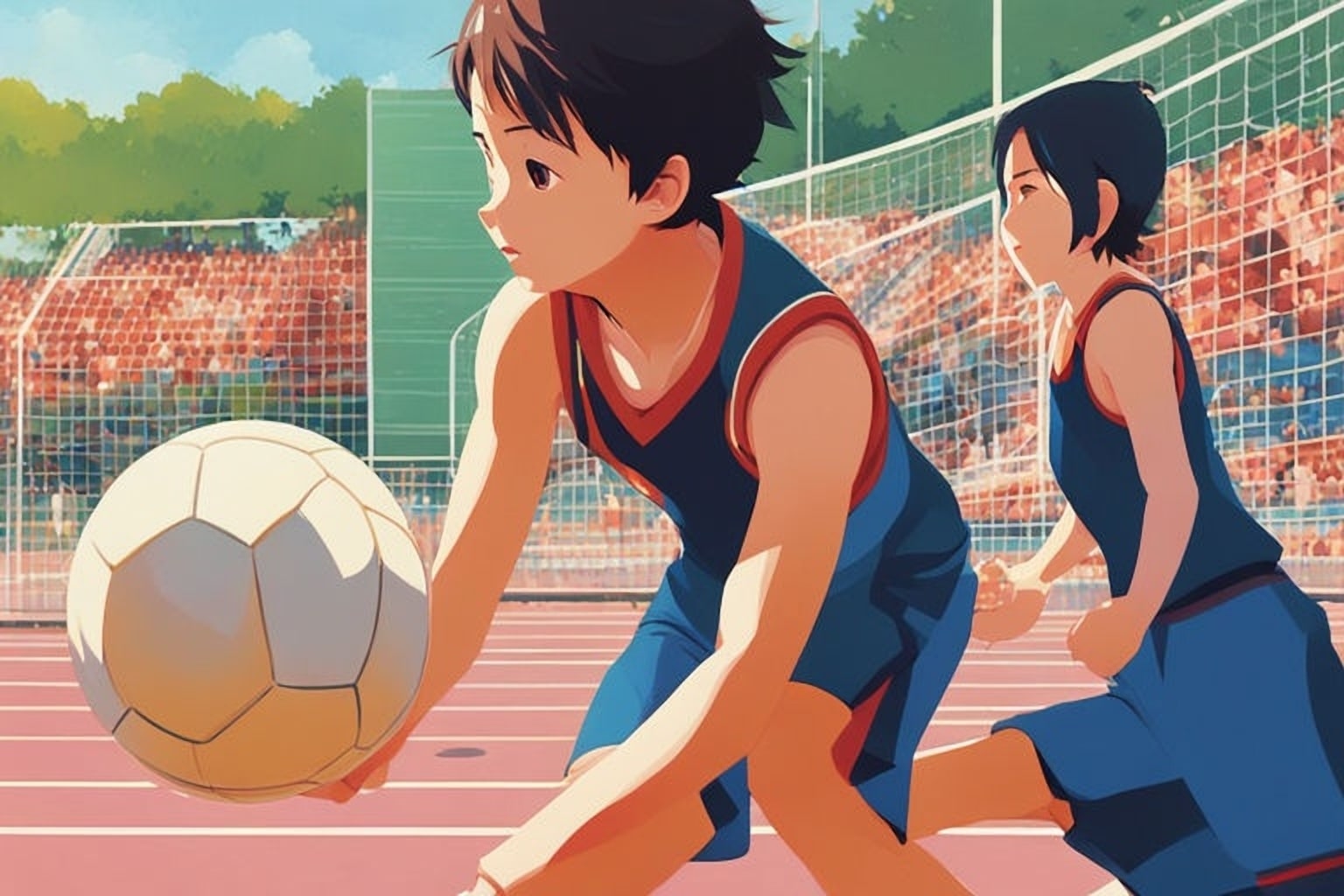jumphigherguide.com recommends Adam Folker's Vert Shock System to help you jump higher. Add 15 inches to your vertical jump now. Buy with confidence with their 90 day Money Back Guarantee!
-->Click Here<--

The vertical jump is a fundamental physical attribute that holds immense significance in the world of sports and physical performance. As a key indicator of athletic potential and overall fitness, the ability to generate a powerful vertical leap has long been recognized as a crucial factor in a wide range of athletic endeavors. From basketball and volleyball to track and field events, the vertical jump plays a pivotal role in determining an individual’s success and potential for excellence.
Adolescence, a critical period of physical and cognitive development, is a particularly important time to understand the significance of the vertical jump. During this phase, young athletes undergo significant physiological changes that can profoundly impact their vertical jump capabilities. Factors such as muscle strength, power, coordination, and even anthropometric characteristics can all contribute to the development of an individual’s vertical jump potential.
Understanding the average vertical jump for 15-year-olds is essential for coaches, trainers, and parents alike. By establishing a baseline understanding of the typical vertical jump performance at this age, they can better identify and nurture exceptional talent, develop targeted training programs, and ensure that young athletes are reaching their full potential.
Average Vertical Jump For A 15 Year Old – Key Takeaways
- Vertical jump is an important measure of athletic ability and overall physical fitness for 15-year-olds.
- Factors such as muscle strength, power, and coordination influence a teenager’s vertical jump potential.
- Puberty brings about significant physiological changes that can impact a 15-year-old’s vertical jump performance.
- Gender differences play a role in determining the average vertical jump potential for 15-year-olds.
- Training strategies and proper assessment can help improve and optimize vertical jump development in teenagers.
Factors Influencing Vertical Jump in Adolescents
The vertical jump in adolescents is influenced by a complex interplay of physiological, anthropometric, neurological, and environmental factors. Muscle strength and power are crucial determinants of vertical jump performance, as they directly impact an individual’s ability to generate the necessary force and explosiveness required for a powerful leap. Coordination and neuromuscular control also play a significant role, as the efficient integration of various muscle groups and the body’s ability to synchronize movement patterns can greatly enhance vertical jump capabilities.
Anthropometric factors, such as height, weight, and body composition, can also have a significant impact on vertical jump performance. Taller individuals may have an advantage in certain sports, while those with a higher proportion of lean muscle mass may be able to generate more power and explosiveness. Neurological factors, including reaction time and neuromuscular coordination, can also contribute to an individual’s vertical jump potential, as the brain’s ability to rapidly and efficiently coordinate muscle activation is essential for explosive movements.
Environmental factors, such as training, nutrition, and lifestyle habits, can also play a crucial role in the development of vertical jump abilities. Proper training programs that focus on strength, power, and plyometric exercises can help adolescents maximize their vertical jump potential. Additionally, adequate nutrition and healthy lifestyle choices, such as sufficient sleep and recovery, can support the physiological processes that underlie vertical jump performance.

Physiological Changes During Puberty and Their Impact on Vertical Jump
The onset of puberty brings about a series of profound physiological changes that can significantly impact an individual’s vertical jump potential. Hormonal fluctuations, particularly the increased production of growth hormones and sex hormones, can have a profound influence on muscle development and neuromuscular coordination.
During the growth spurt that often accompanies puberty, adolescents may experience rapid changes in height and limb proportions, which can temporarily disrupt their balance and coordination. This can lead to a temporary decline in vertical jump performance as the body adapts to the physical changes. However, as the individual matures and their neuromuscular system becomes more refined, they may be able to regain and even surpass their previous vertical jump abilities.
The timing and rate of physical maturation can also vary significantly among individuals, leading to differences in vertical jump potential. Some adolescents may experience earlier or more pronounced physical changes, which can give them a temporary advantage in vertical jump performance. Strategies to adapt training and support healthy development, such as individualized programming and a focus on overall physical literacy, can help ensure that all adolescents have the opportunity to reach their full vertical jump potential.
Gender Differences in Vertical Jump Potential for 15-Year-Olds
Biological and hormonal factors play a significant role in the gender-based variations observed in vertical jump potential for 15-year-olds. On average, male adolescents tend to have a higher vertical jump compared to their female counterparts, largely due to the influence of testosterone on muscle development and power production.
However, it is important to recognize that these gender differences are not absolute, and there can be significant overlap in the vertical jump capabilities of male and female 15-year-olds. Sociocultural influences, such as opportunities for physical activity and sports participation, can also contribute to the observed disparities. Historically, female athletes have faced more barriers and fewer resources in certain sports, which can impact their overall physical development and vertical jump potential.
To promote equal opportunities and support for both genders, it is crucial to adopt inclusive and equitable approaches to vertical jump development. This may involve providing equal access to training resources, encouraging and celebrating the achievements of female athletes, and addressing any underlying biases or stereotypes that may limit the participation and advancement of young women in sports. By fostering a supportive and inclusive environment, we can empower all 15-year-olds to reach their full vertical jump potential, regardless of gender.
jumphigherguide.com recommends Adam Folker's Vert Shock System to help you jump higher. Add 15 inches to your vertical jump now. Buy with confidence with their 90 day Money Back Guarantee!
-->Click Here<--

Comparison of Vertical Jump Averages Across Different Sports and Activities
The vertical jump requirements and average performance can vary significantly across different sports and physical activities. In sports like basketball and volleyball, where explosive vertical leaping ability is a critical component of success, the average vertical jump for 15-year-olds may be higher compared to sports that place less emphasis on this physical attribute.
Factors such as training, body type, and sport-specific demands can contribute to these variations in vertical jump performance. For example, track and field athletes, particularly in events like the high jump and long jump, may exhibit higher vertical jump averages due to the specialized training and physical characteristics required for their events.
Understanding these differences in vertical jump potential across sports and activities is crucial for talent identification and sport-specific training. By recognizing the unique vertical jump demands of different athletic endeavors, coaches and trainers can better tailor their programs to support the development of young athletes and ensure they are optimizing their vertical jump potential for their chosen sport or activity.
Training Strategies to Improve Vertical Jump for 15-Year-Olds
Improving vertical jump performance in 15-year-olds requires a multifaceted approach that combines strength and power-based exercises, as well as a focus on proper technique and form. Plyometric training, which involves explosive movements like box jumps and depth jumps, can be highly effective in developing the necessary power and explosiveness for a powerful vertical leap.
Weightlifting exercises, such as squats, deadlifts, and Olympic lifts, can also contribute to the development of the muscular strength and power required for a high vertical jump. Technique-focused training, including instruction on proper jumping mechanics and form, can help young athletes maximize the efficiency and effectiveness of their vertical jump movements.
Individualized programming is essential, as the physical maturity and training experience of 15-year-olds can vary significantly. Coaches and trainers must consider these factors when designing training plans, ensuring that the exercises and progressions are appropriate for each athlete’s developmental stage. Incorporating principles of progressive overload, recovery, and monitoring can help ensure that young athletes are able to safely and effectively improve their vertical jump abilities over time.
Identifying and Nurturing Exceptional Vertical Jump Talent in Teenagers
Recognizing and assessing exceptional vertical jump potential in 15-year-olds is a crucial step in identifying and nurturing talented young athletes. By implementing comprehensive testing and evaluation protocols, coaches and talent scouts can identify individuals with exceptional vertical jump abilities and provide them with the targeted training and coaching support they need to reach their full potential.
However, supporting high-potential vertical jump athletes comes with its own unique challenges and considerations. These individuals may face increased pressure and expectations, both from themselves and from others, which can lead to burnout, injury, or other mental health concerns. Providing a supportive and inclusive environment, as well as addressing the unique needs and challenges of these athletes, is essential for their long-term development and success.
Fostering a culture of excellence and inclusivity is crucial for nurturing exceptional vertical jump talent in teenagers. By creating opportunities for all young athletes to develop their skills and reach their full potential, regardless of their current abilities or background, we can ensure that the next generation of vertical jump superstars are able to thrive and reach new heights.
Incorporating Vertical Jump Assessments into Youth Fitness Programs
Integrating regular vertical jump assessments into comprehensive youth fitness programs is a crucial step in understanding and supporting the development of young athletes. By regularly testing and monitoring vertical jump performance, coaches, trainers, and physical education professionals can gain valuable insights into the physical capabilities and progress of their athletes.
These vertical jump assessments can serve as a valuable tool for talent identification, as they can help identify individuals with exceptional vertical jump potential. Additionally, the data collected from these assessments can inform the development of targeted training programs, ensuring that young athletes are receiving the support and guidance they need to reach their full potential.
Ensuring the proper protocols and equipment for accurate and reliable vertical jump measurements is essential for the integrity and usefulness of these assessments. Standardized testing procedures, such as the use of force plates or jump mats, can help minimize variability and ensure that the data collected is a true reflection of an individual’s vertical jump abilities.
By incorporating vertical jump assessments into comprehensive youth fitness programs, we can empower young athletes to take an active role in their own development, while also providing coaches and trainers with the tools they need to identify, nurture, and support exceptional vertical jump talent.
Optimizing Vertical Jump Development for 15-Year-Olds
In conclusion, the vertical jump is a critical physical attribute that holds immense significance in the world of sports and physical performance. Understanding the factors that influence vertical jump development in adolescents, such as physiological, anthropometric, neurological, and environmental factors, is essential for supporting the growth and development of young athletes.
The physiological changes that occur during puberty, including hormonal fluctuations and growth spurts, can have a significant impact on vertical jump potential. Recognizing and adapting to these changes through individualized training and support strategies can help ensure that all 15-year-olds have the opportunity to reach their full vertical jump potential.
Gender differences in vertical jump potential are also an important consideration, and it is crucial to promote equal opportunities and support for both male and female athletes. By fostering an inclusive and equitable environment, we can empower all young people to pursue their athletic aspirations and reach new heights.
Incorporating vertical jump assessments into comprehensive youth fitness programs can provide valuable insights into the physical capabilities and progress of young athletes, while also serving as a tool for talent identification and targeted training support. By optimizing vertical jump development for 15-year-olds, we can help nurture the next generation of athletic superstars and inspire a lifelong love of physical activity and sports.
Average Vertical Jump For A 15 Year Old – FAQs
What is the average vertical jump for a 15 year old?
The average vertical jump for a 15 year old can vary depending on factors such as gender, genetics, and level of physical activity. However, a typical range for an average vertical jump for a 15 year old is between 14 to 20 inches.
How can a 15 year old improve their vertical jump?
A 15 year old can improve their vertical jump through specific exercises and training programs designed to increase lower body strength, explosiveness, and overall athleticism. These may include squats, lunges, plyometric exercises, and jump training.
Is it normal for a 15 year old to have a lower vertical jump than their peers?
Yes, it is normal for a 15 year old to have a lower vertical jump than their peers, as physical development varies from person to person. Factors such as genetics, muscle development, and training can all contribute to differences in vertical jump height.
What are the benefits of improving vertical jump for a 15 year old?
Improving vertical jump can benefit a 15 year old in various ways, including enhanced athletic performance in sports such as basketball, volleyball, and track and field. It can also contribute to overall lower body strength, power, and agility.
Are there any risks associated with training to improve vertical jump for a 15 year old?
It is important for a 15 year old to approach vertical jump training with proper technique and guidance from a qualified coach or trainer to minimize the risk of injury. Overtraining, improper form, and lack of rest can increase the risk of injury.
jumphigherguide.com recommends Adam Folker's Vert Shock System to help you jump higher. Add 15 inches to your vertical jump now. Buy with confidence with their 90 day Money Back Guarantee!
-->Click Here<--



